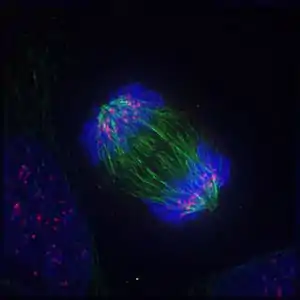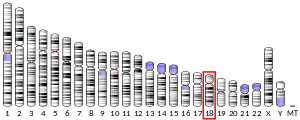| TTC39C | |||||||||||||||||||||||||||||||||||||||||||||||||||
|---|---|---|---|---|---|---|---|---|---|---|---|---|---|---|---|---|---|---|---|---|---|---|---|---|---|---|---|---|---|---|---|---|---|---|---|---|---|---|---|---|---|---|---|---|---|---|---|---|---|---|---|
| Identifiers | |||||||||||||||||||||||||||||||||||||||||||||||||||
| Aliases | TTC39C, C18orf17, HsT2697, tetratricopeptide repeat domain 39C | ||||||||||||||||||||||||||||||||||||||||||||||||||
| External IDs | MGI: 1919997 HomoloGene: 124438 GeneCards: TTC39C | ||||||||||||||||||||||||||||||||||||||||||||||||||
| |||||||||||||||||||||||||||||||||||||||||||||||||||
| |||||||||||||||||||||||||||||||||||||||||||||||||||
| |||||||||||||||||||||||||||||||||||||||||||||||||||
| |||||||||||||||||||||||||||||||||||||||||||||||||||
| Wikidata | |||||||||||||||||||||||||||||||||||||||||||||||||||
| |||||||||||||||||||||||||||||||||||||||||||||||||||
Tetratricopeptide repeat protein 39C is a protein that in humans is encoded by the TTC39C gene. TTC39C is one of three TTC39.[5] Its function is currently unknown; however, there is some evidence suggesting that it plays a role in anaphase.[6][7] It also contains a relatively well-characterized structural motif called the tetratricopeptide repeat (TPR).
Gene
TTC39C is located on the long arm of human chromosome 18 at 18q11.2.[8] Its most common aliases are FLJ33761, C18orf17, and HsT2697.[8]
Protein
The TTC39C protein is 583 amino acids long, and appears to be localized to the cytoplasm of the cell based on its predicted secondary structure[9] It has three isoforms, the longest of which is transcript variant 1.[8] It contains three tetratricopeptide repeats, as well as the domain of unknown function DUF3808.[5] The protein product has a molecular weight of 65.9 kDa and an isoelectric point of 6.584.[10][11] There are several predicted phosphorylation, acetylation, and palmitoylation sites, which are shown in the table below.[12] Its whole predicted secondary structure is composed almost entirely of helices, and forms a tertiary structure that is predicted to match the structure of the cut9 protein in yeast with 100% accuracy and 85% coverage.[6][13]
| Type | Location[12] | Function[14] | Quality of Sites |
|---|---|---|---|
| Phosphorylation |
|
Regulation of cell cycle, apoptosis, cell signaling, etc. | High |
| Acetylation |
|
Regulates gene expression | Moderate |
| Palmitoylation |
|
Anchors Protein to membrane | Moderate |
Homology
The TTC39C protein is over 50% conserved in most vertebrates, and has conservation levels as low as about 24% in invertebrates.[15] At least one ortholog and several homologs have also been identified in fungi.[8] No orthologs have been identified in plants.[8] Several of its orthologs are shown in the table below.
| Scientific Name | Common Name | Mean Predicted Date of Divergence (MYA)[16] | Protein Length (aa) [15] | RNA NCBI Accession Number [15] | Protein NCBI Accession Number [15] | RNA Identity [15] | Protein Identity [15] |
|---|---|---|---|---|---|---|---|
| Callithrix jacchus | Marmoset | 42.6 | 522 | XM_002807499 | XP_002807545 | 42.2% | 99.4% |
| Anolis carolinensis | Anole | 296.0 | 574 | XM_003219667 | XP_003219715 | 27.7% | 81.7% |
| Gallus gallus | Chicken | 296.0 | 576 | XM_419163 | XP_419163 | 36.1% | 88.0% |
| Xenopus tropicalis | Western Clawed Frog | 371.2 | 570 | NM_001113821 | NP_001107293 | 55.20% | 88.0% |
| Oreochromis niloticus | Tilapia | 400.1 | 578 | XM_003444269 | XP_003444317 | 24.0% | 70.2% |
| Apis mellifera | Honeybee | 782.7 | 877 | XM_001120231 | XP_001120231 | 38.7% | 24.3% |
| Saccharomyces cerevisiae | Baker's Yeast | 1215.8 | 725 | NM_001179808 | NP_012943 | 29.7% | 17.6% |
TTC39C has two paralogs from the TTC39 family: TTC39A, and TTC39B, which are located on chromosome 1, at 1p32.3 and chromosome 9, at 9p22.3 respectively. TTC39B has been associated with the management of HDL cholesterol, and may be involved in the prevention of cardiovascular disease [17]
Expression

The promoter region controlling expression of transcript variant 1 begins approximately 952 bases upstream of the start codon, and includes the entire 5' UTR.[19] Several possible transcription factor binding sites have been identified using the program El Dorado including the CCCTC binding factor and a site for CTCF, an insulator protein that binds CCCTC.[19] This transcription factor is associated with a number of functions including organization of chromatin.[20] There were also several sites that appear to be the general transcription factor TFIIB, and both E2F and E2F transcription factor binding sites.[19] The E2F transcription factors are involved in mediating the cell cycle, which could be a potential link to the hypothesized role of TTC39C in anaphase.[21] Several microarray studies of humans, dogs and mice have provided evidence that TTC39C is most highly expressed in the liver.[18][22][23] It exhibits relatively high expression in all tissues, and had a percentile rank above 50% in all tissues except in kidney, spinal cord, and skeletal muscle samples of humans.[18]
Function

The function of TTC39C is currently unknown.[8] However, one of its structural motifs, the tetratricopeptide repeat is relatively well characterized, and has been shown to be active primarily in four categories of protein-protein interactions: interacting with molecular chaperones, mediating the start of anaphase during cell division, transcription repression, and the transport of proteins.[7] Of these four areas of functionality, the most evidence exists for its involvement in the initiation of anaphase. Two of the three possible interacting proteins identified by STRING play a role in anaphase.[24] Finally, the protein that had a structure that appears to perfectly match 85% of the TTC39C sequence is involved in anaphase in the yeast, Schizosaccharomyces pombe.[6] However, the role of TTC39C in anaphase must be confirmed through additional studies.
Interactions

Textmining studies have identified several proteins that TTC39C may interact with.[24] These protein-protein interactions have not been confirmed; however, two of the identified proteins, AGBL1 and HAUS4, are likely candidates due to their roles in anaphase.[24] Additional potential protein-protein interactions were identified for TTC39C in mice; however, there is no apparent connection to TTC39C besides coexpression.
References
- 1 2 3 GRCh38: Ensembl release 89: ENSG00000168234 - Ensembl, May 2017
- 1 2 3 GRCm38: Ensembl release 89: ENSMUSG00000024424 - Ensembl, May 2017
- ↑ "Human PubMed Reference:". National Center for Biotechnology Information, U.S. National Library of Medicine.
- ↑ "Mouse PubMed Reference:". National Center for Biotechnology Information, U.S. National Library of Medicine.
- 1 2 NCBI. "TTC39C tetratricopeptide repeat domain 39C [ Homo sapiens (human) ]". U.S. National Library of Medicine. Retrieved 4 May 2013.
- 1 2 3 "Phyre2". Retrieved 18 April 2013.
- 1 2 Blatch GL, Lässle M (November 1999). "The tetratricopeptide repeat: a structural motif mediating protein-protein interactions". BioEssays. 21 (11): 932–9. doi:10.1002/(SICI)1521-1878(199911)21:11<932::AID-BIES5>3.0.CO;2-N. PMID 10517866.
- 1 2 3 4 5 6 Genecards. "TTC39C Gene". Weizmann Institute of Science. Retrieved 4 May 2013.
- ↑ Nakai and Horton. "PSORTII". Retrieved 4 May 2013.
- ↑ San Diego Supercomputer's Biology Workbench. "SAPS". Retrieved 9 May 2013.
- ↑ San Diego Supercomputer's Biology Workbench. "PI". Retrieved 9 May 2013.
- 1 2 SIB Swiss Institute of Bioinformatics. "ExPASy". Retrieved 9 May 2013.
- ↑ San Diego Supercomputer-Biology Workbench. "PELE". Retrieved 4 May 2013.
- ↑ Thermo Scientific. "Overview o Post-Translational Modifications". Thermo Fisher Scientific Inc. Retrieved 9 May 2013.
- 1 2 3 4 5 6 NCBI. "BLAST". National Library of Medicine. Retrieved 8 May 2013.
- ↑ Kimar and Hedges. "Time Tree". Retrieved 11 May 2013.
- ↑ Kathiresan S, Willer CJ, Peloso GM, Demissie S, Musunuru K, Schadt EE, Kaplan L, Bennett D, Li Y, Tanaka T, Voight BF, Bonnycastle LL, Jackson AU, Crawford G, Surti A, Guiducci C, Burtt NP, Parish S, Clarke R, Zelenika D, Kubalanza KA, Morken MA, Scott LJ, Stringham HM, Galan P, Swift AJ, Kuusisto J, Bergman RN, Sundvall J, Laakso M, Ferrucci L, Scheet P, Sanna S, Uda M, Yang Q, Lunetta KL, Dupuis J, de Bakker PI, O'Donnell CJ, Chambers JC, Kooner JS, Hercberg S, Meneton P, Lakatta EG, Scuteri A, Schlessinger D, Tuomilehto J, Collins FS, Groop L, Altshuler D, Collins R, Lathrop GM, Melander O, Salomaa V, Peltonen L, Orho-Melander M, Ordovas JM, Boehnke M, Abecasis GR, Mohlke KL, Cupples LA (January 2009). "Common variants at 30 loci contribute to polygenic dyslipidemia". Nat. Genet. 41 (1): 56–65. doi:10.1038/ng.291. PMC 2881676. PMID 19060906.
- 1 2 3 Affymetrix, Inc. "GDS424 / 64649_at / TTC39C". NCBI- GEO Profiles. Retrieved 4 May 2013.
- 1 2 3 "El Dorado-TTC39C". Genomatix. Retrieved 4 May 2013.
- ↑ Phillips JE, Corces VG (June 2009). "CTCF: master weaver of the genome". Cell. 137 (7): 1194–211. doi:10.1016/j.cell.2009.06.001. PMC 3040116. PMID 19563753.
- ↑ Zheng N, Fraenkel E, Pabo CO, Pavletich NP (March 1999). "Structural basis of DNA recognition by the heterodimeric cell cycle transcription factor E2F-DP". Genes Dev. 13 (6): 666–74. doi:10.1101/gad.13.6.666. PMC 316551. PMID 10090723.
- ↑ Affymetrix, Inc. "GDS4164 / CfaAffx.27815.1.S1_s_at / TTC39C". NCBI-GeoProfiles. Retrieved 4 May 2013.
- ↑ EBI. "Ttc39c differential expression summary". Retrieved 4 May 2013.
- 1 2 3 4 "STRING - Known and Predicted Protein-Protein Interactions". Retrieved 2 May 2013.



